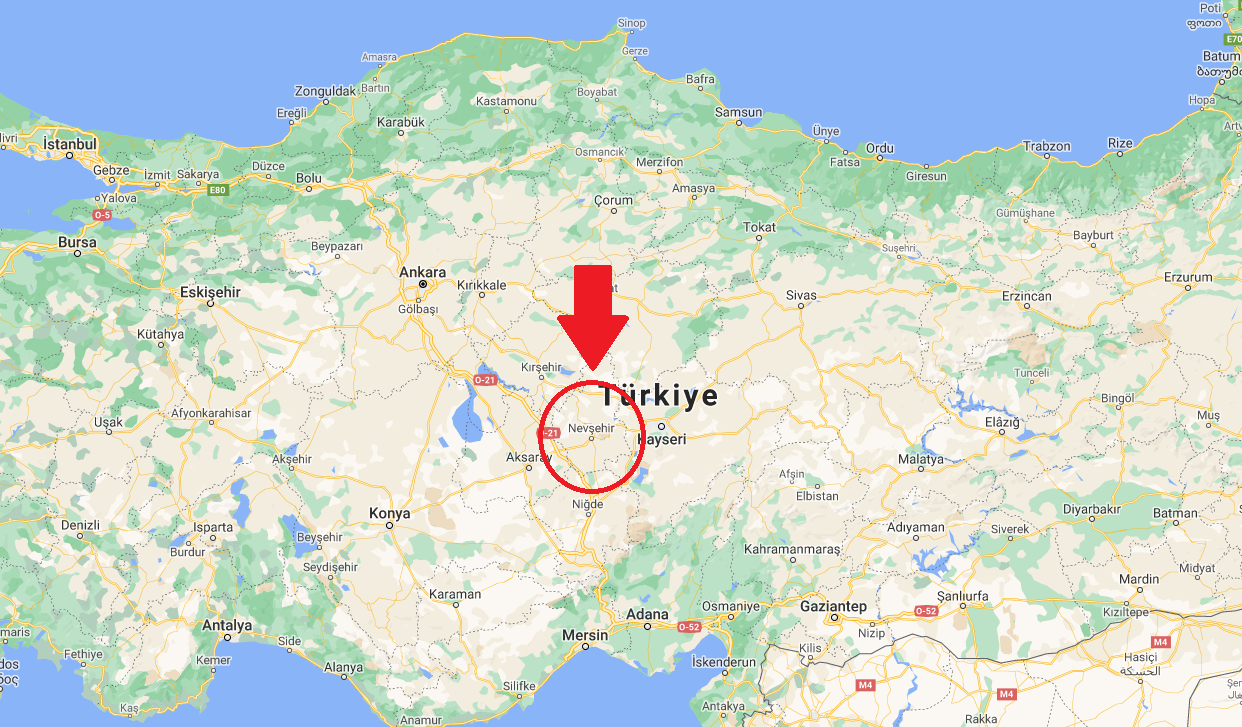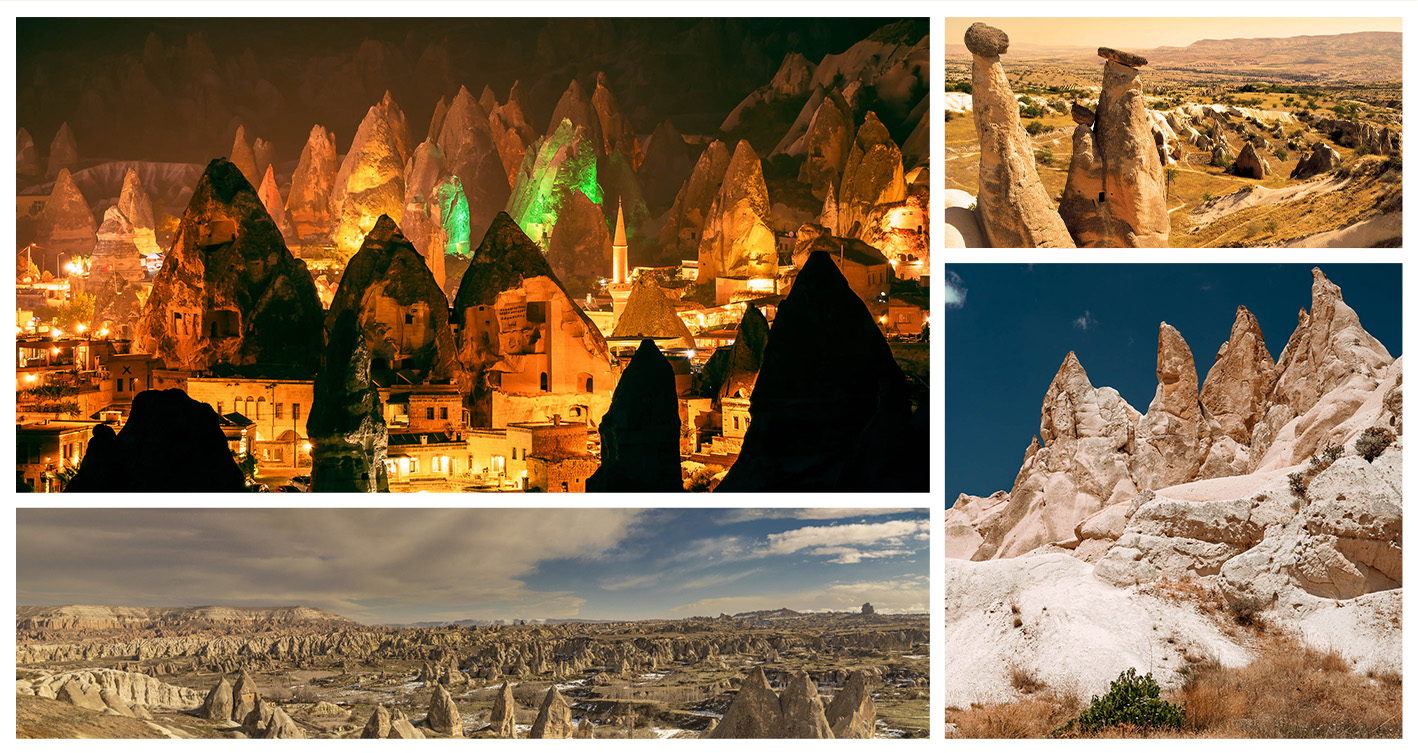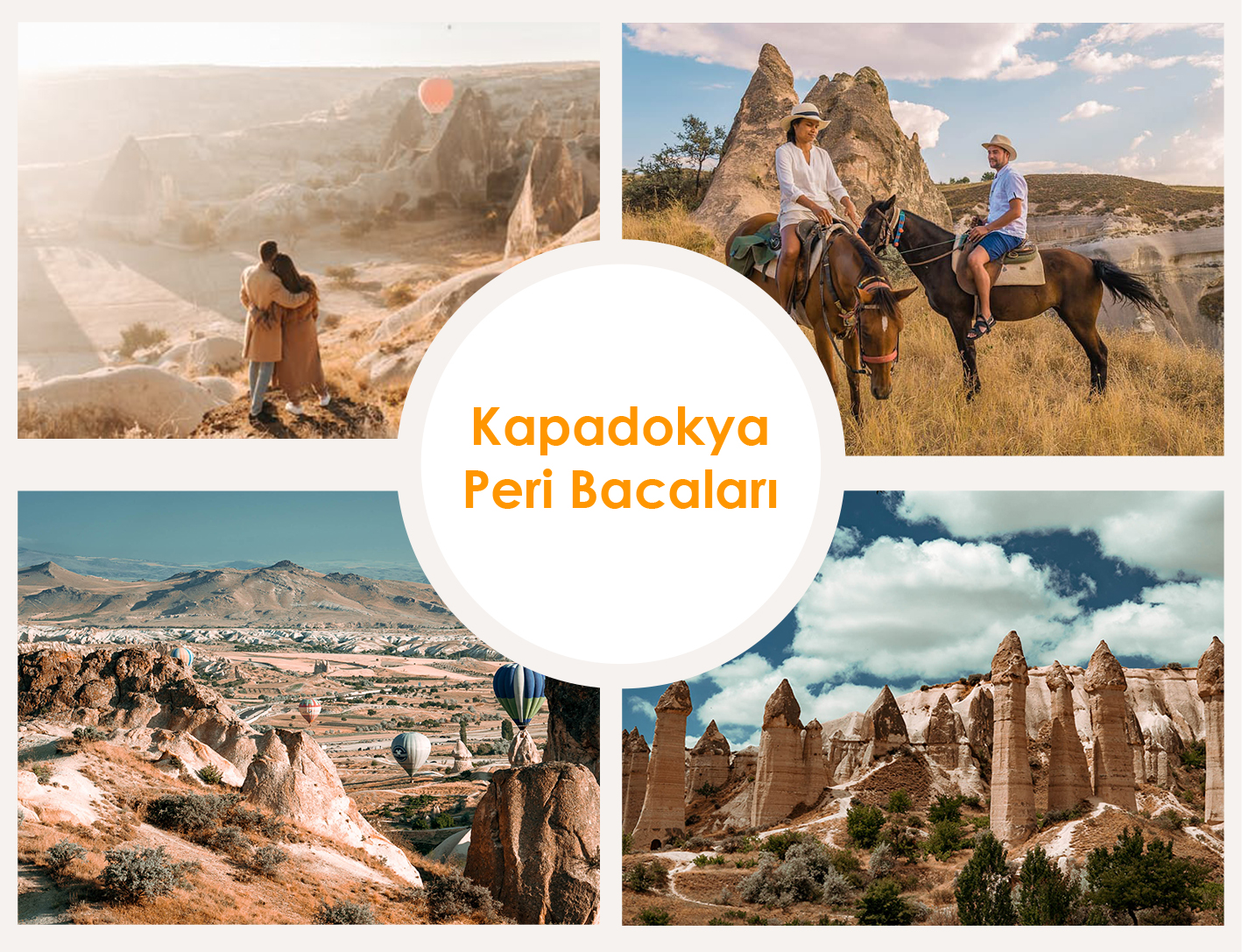When it comes to Cappadocia Fairy Chimneys, the first things that come to mind are the objects with a thick body, a thin neck, and a mushroom head. What is not known about the Fairy Chimneys is that not only mushroom-headed structures but also every natural soil structure in the Cappadocia Region is a Fairy Chimney. Fairy Chimneys are extraordinary structures shaped by the winds and rains of nature, apart from forests and vegetation. Cappadocia: It is the region formed by the provinces of Aksaray, Nevsehir, Kırsehir and Kayseri. Every non-man-made earthen structure you can see in this region can be called a Fairy Chimney. Fairy Chimneys have been in existence since 10 million years ago. Today, while a Fairy Chimney disappears in the Cappadocia region, a new one is forming in another place.
Cappadocia Fairy Chimneys Formation – How Were Fairy Chimneys Formed?
Cappadocia is a region that fascinates people with its natural geography, and the biggest example of this is the Fairy Chimneys. Fairy Chimneys have a story that will truly fascinate people. In addition to their interesting appearance, the story behind them is as interesting as they are. According to the information we have in today’s sources, the formation of Fairy Chimneys dates back 60 million years. 60 million years ago, the region we now call Cappadocia was known as a large lake or inland sea. According to the information confirmed by archaeologists, the Anatolian fault line was compressed with the rise of the Taurus Mountains in the 3rd geological period. Compression of fault lines caused Hasan and Erciyes volcanoes to become active. These events, which took place 60 million years ago, left us this incredible natural geographical region.
As a result of the eruption of Hasan and Erciyes volcanoes, the lake was filled with lava and remained under ash rain for thousands of years. The ash rains ended only after a very long time, and the natural events in the region started to happen again. Rains falling over time are lava-filled into the layer and form cracks. Over time, these cracks helped to widen and the wind to reach and erode the soft layer. Fairy Chimneys are still forming as a result of erosion by wind and rain in this region where a long and big natural event took place. You can find visual information about the formation of Fairy Chimneys from the drawing below. Of course, these events take place over hundreds of thousands of years and continue.

Cappadocia Fairy Chimneys History
The Cappadocia Region has hosted almost hundreds of societies from the Hittite and Assyrian Trade Colonies to today’s Republic of Turkey. The Anatolian region has been attacked by many societies for thousands of years due to its geographical location to have these fertile lands. But the history of the region goes back much earlier than these events. The rise of the Taurus
Mountains in Anatolia 60 million years ago are considered the beginning of these events.
The rise of the Taurus Mountains caused the compression of the fault line in Anatolia and activated the volcanoes. This event, dated to the 3rd geological period, triggered the Hasan and Erciyes volcanoes. Before the volcanic eruptions, Cappadocia, which we call the Inland Sea or Lake, was filled with ash and lava. Ash and lava could only be cleared by rain and wind after millions of years. We can say that this event, which has left the Fairy Chimneys consisting of the hardtop and soft tuff rocks, is a miracle of nature.
Many societies have lived in the Cappadocia region of Anatolia. These societies living in Anatolia also used these easy-to-dig soil surfaces as shelters. The first use of the Underground Cities, which we visit with admiration today, was to store food. These societies, which enlarged this soft tuff surface in the form of chambers, formed the Underground Cities over time. You can contact us to see the wonderful Fairy Chimneys in the Cappadocia region and join the tours.
What are Fairy Chimneys?
Fairy Chimneys in the Cappadocia region are landforms dating back 60 million years. Fairy Chimneys are seen in three ways; Mushroom shapes that have completely completed their formation are the ones everyone is accustomed to seeing. Those whose soft tuff has been eroded by rain and wind, and whose neck and body have not been exposed, although the hard tuff head is visible. Finally, mounds of uneroded soft and hard tuff rocks.
In the article above, we gave general information about the formation of Fairy Chimneys. If you ask; It is the state of the building, which is formed by lava and ash rains, and the layers are eroded over time by natural events. These structures wear out over time and lose their mushroom heads. The soft tuff, which is getting weaker, falls because it can no longer support its hard head. During this event, a new Fairy Chimney is formed in another place.
Where is Cappadocia (Where Are The Fairy Chimneys)

The Cappadocia Region consists of Nevsehir, Aksaray, Kırsehir and Kayseri provinces. The Central Anatolia region, in which these provinces are located, is home to many geographical riches. Many of these are historical sites and also have excellent views. Fairy Chimneys are just one of these historical riches and sights. Fairy Chimneys, which are seen in almost 70% of the Cappadocia region, are mostly located in Nevsehir province. It is located in the central point of Turkey, and at the same time, it can be easily reached with its proximity to the East and West.
How many km is Istanbul to Cappadocia Nevşehir? Cappadocia to Istanbul? The distance between Istanbul and Nevsehir is 700 km and it takes 6-7 hours by car but 2 hours by plane.
How Many Km Is Antalya to Cappadocia Nevşehir? The distance between Antalya and Nevsehir is 520 km and it takes 4-5 hours by car, but if you want to travel by plane, it takes 1.5 hours.
Where can you view Fairy Chimneys?
Cappadocia, which has natural geography, is also home to wonderful landscapes and peaceful Valleys. We can call the Valleys in the Cappadocia Region as Fairy Chimneys that have not yet formed. The valleys with Fairy Chimneys, which continue to form many of them halfway, are home to incredible views. Due to its hilly and mountainous areas, the Central Anatolia region offers views that you can watch from above. The Valleys in Cappadocia will also be a great choice to watch the Fairy Chimneys. In addition to its beauties that you can see from afar, observing the surroundings while inside the Valley will offer you a wonderful view. We have listed the wonderful places for you to watch Fairy Chimneys in Cappadocia. You can reach our Cappadocia Valleys’ article below for Kızılcukur Valley, Pasabag Fairy Chimneys, Dervent Valley, and more.
Cappadocia Valleys
There are also many Valleys in the Cappadocia region, which is famous for its Fairy Chimneys. Besides being a part of the Cappadocia region, the valleys are home to wonderful views. The fact that the vegetation of Cappadocia is Bozkır also allows it to be mixed with the brown tone. This region, where you can usually see very little greenery, is full of brown Valleys. These valleys contain Fairy Chimneys that have completed their formation or are in the process of formation.
If we list the Valleys, each of which has unique beauties;
Red Valley – Kızılcukur Valley
The Red Valley, which takes its name from the fact that it turns completely red at sunset, is a Valley full of Fairy Chimneys. This Valley, which contains many Fairy Chimneys that are being formed and formed, is a sight worth seeing. This Valley, which offers you a wonderful view due to its height; You can put it in the first place as the place you should choose for the sunset and Fairy Chimneys watching. You can find more detailed information about Kızılçukur Valley here.
Dervent Valley – Imagination Valley
Dervent Valley, also known as Imagination Valley, has interesting Fairy Chimneys. The Fairy Chimneys with interesting shapes in it, and some objects by using a little imagination.
You can compare. Fairy Chimneys in the Valley; Virgin Mary, Tortoise, Camel, two ducks side by side, Crocodile, and many other shapes and animals are likened. When you go in the morning or at noon when the sun is high, the shapes are seen more clearly. You can find more detailed information about Dervent Valley here.

Ihlara Valley
It is a green area that is rarely seen in the Cappadocia Region, which we can call fifty shades of brown. Ihlara Valley National Park, which contains a river, is seen as a tree growing in the big soil. Located within the borders of the Guzelyurt district of Aksaray province, this Valley contains many churches. It is home to many plants and trees growing on the riverbed in this precious canyon with a length of 18 km. The valley usually has steep and deep walls. We recommend you see this valley, which has a wonderful view due to its height. You can find more detailed information about Ihlara Valley and other valleys here.
Pigeon Valley
Pigeon breeding is very common in the Cappadocia region. One of the reasons for this is Pigeon Fertilizer has been used for the good preservation of the Frescoes in the Churches over the years. Pigeon manure has a great effect on grape farming, which is quite abundant in the Cappadocia region. Small square holes you can see in many Valleys in the Cappadocia region are pigeon nests. Pigeon Valley in Cappadocia is an incredible place for scenery and also for trekking. You can find more detailed information about Ilhara Valley here.
Fairy Chimneys Legend
Fairy Chimneys have many legends besides their flamboyant beauty. However, the most common and most striking story among these is the one about giants. According to the story told about the Fairy Chimneys; Once upon a time, giants as tall as mountains lived in the Cappadocia region. When the giants in the mountains were angry with what people did, they hurt them. The giants, who sent terrible waves of flame to people from the height of the mountains, were quite dangerous for humans. For this reason, people tried to live by being careful not to anger the giants.
At that time, the king of the fairyland, Cappadocia, the land of people living under the tyranny of these giants, came across the road. The king, who felt sorry for the people, decided to help by calling the fairies to the region and calling all the fairies. Fairies; However, if we scare the giants and smuggle them underground, these people will find peace. Thousands of fairies who came here started to throw snow and ice grains in their hands into terrible fires. They managed to extinguish the fire by interfering with both ice and snow without stopping. After this day, a friendship has formed between humans and fairies.
In the houses that people carved out of the stones, the fairies began to live in small holes at the ends of the pointed rocks. Revan, a very handsome son of the King of Humans, and Gulperi, a very beautiful daughter of the King of Fairies; Known for her beauty, Gulperi saw in her dream an attractive young man whom she believed she would never see in real life. Gulper fell in love with Revan, whom she saw in her dream, and they wanted to get married. However, the people did not allow this marriage and decided to fight the Fairies so that the marriage would be annulled.
When the sultan of the fairies learned about this event, he preferred to leave instead of fighting and ending thousands of lives. However, when he left, he thought that people could not cope with the giants and ordered all the fairies under his command to become pigeons and told them to stay in the same place. Thus, the Fairies created pigeon nests in the valleys and continued to live there. The princess, who turned into a white dove, went to visit Revan every day.

If you want a get more information about Cappadocia and Cappadocia Fairy Chimneys you can contact our Agency
Contact
Whatsapp: 0530 540 37 79
E-Mail: info@htrtours.com
Telefon: 0384 341 55 48
FAQ
Where is Turkey Cappadocia? Cappadocia Airport, Where are the Cappadocia Hot Air Balloons?

